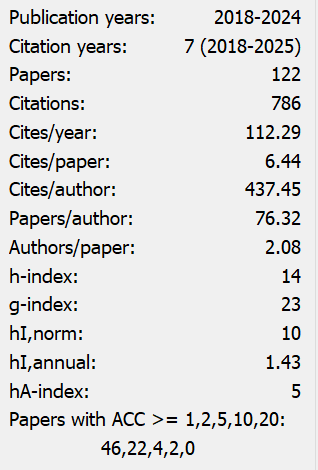The Effect of Social Crowdedness on Preference for Utilitarian Products
Abstract
In a modern society with high population density, consumers usually face crowded consumption environment. Meanwhile, the choices they can make are more and more abundant. Is there any correlation between social crowdedness and the preference for different types of products?
This research investigates whether social crowdedness, defined as the number of people in a given area—impacts consumers’ propensity to choose functional products rather than hedonic products. We propose that social crowdedness increases the likelihood of preference for functional products rather than hedonic products. This effect occurs because density settings make consumers experience a loss of perceived control, which in turn makes them engage in interpretive cognition, exhibit a desire for structured and meaningful products, and practical function of the product as a compensatory method to help them regain control.
Two studies provide support for this hypothesis. Study 1 confirms the relationship between social crowdedness and the product type preference. Study 2 examined the mediating role of perceived control as the underlying mechanism, which is, social crowdedness gives rise to a feeling of loss of perceived control, to fill up this, consumers seek products with more practical and useful function feature rather than hedonic and pleasure-oriented products as compensation to fill the gap.
This study expands the research in the fields of social crowdedness from consumer behavioral perspectives. Also, the research may contribute to the marketing planning of different types of commodities in various environments.
References
Alloy, L. B., & Abramson, L. Y. (1979). Judgment of contingency in depressed and nondepressed students: Sadder but wiser? Journal of Experimental Psychology: General, 108, 441-483. https://doi.org/10.1037/0096-3445.108.4.441
Cain, C. K., & Joseph, E. L. (2008). Emotional Processing and Motivation: In Search of Brain Mechanisms, Handbook of Approach and Avoidance Motivation, ed. Andrew J. Elliot, New York: Psychology Press. https://doi.org/10.1073/pnas.1619316114
Chen, X., & Li, J. Y. (2022). The Impact of Social Crowding on Color Saturation Preference -The Mediating Role of Threat to Freedom and Avoidance Behavior , International Conference of Technological Forecasting and Social Change Conference.
Consiglio, I, De Angelis, M., Costabile, M., et al. (2018).The Effect of Social Density on Word of Mouth. Journal of Consumer Resesrch, 45(3), 511-528. https://doi.org/10.1093/jcr/ucy009
Cutright, K. M. (2012). The Beauty of Boundaries: When and Why We Seek Structure in Consumption,Journal of Consumer Research, 38(5), 775-790. https://doi.org/10.1086/661563
Cutright, K. M., James, R. B., & Gavan, J. F. (2013).Putting Brands in Their Place: How a Lack of Control Keeps Brands Contained.Journal of Marketing Research, 50(3), 365-377.
Deci, E. L., & Ryan, R. M. (1987). The support for autonomy and the control of behavior. Journal of Personality and Social Psychology, 53, 1024-1037.https://doi.org/10.1037/0022-3514.53.6.1024
Eroglu, S. A., Karen, M., & Terri, F. B. (2005). Perceived Retail Crowding and Shopping Satisfaction: The Role of Shopping Values. Journal of Business Research, 58(8), 1146-1153.
Fiske, S. T., & Morling, B. (1996). Stereotyping as a function of personal control motives and capacity constraints: The odd couple of power and anxiety. In R. M. Sorrentino & E. T. Higgins (Eds.), Handbook of motivation and cognition, Vol. 3. The interpersonal context,pp. 322-346. New York: Guilford Press.
Fritsche, I., Jonas, E., & Fankhänel, T. (2008). The role of control motivation in mortality salience effects on ingroup support and defense. Journal of Personality and Social Psychology, 95(3), 524-541. https://doi.org/10.1037/a0012666
Gao, W. J. (2005), Psychological Explanation of Feel of Control[D]. Jilin University.
Garbarino, J. (1975). The impact of anticipated reward upon cross-age tutoring. Journal of Personality and Social Psychology, 32, 421-428. https://doi.org/10.1037/h0077087.
Griffit, W., & Russell, V. (1971). Hot and Crowded: Influence of Population Density and Temperature on Interpersonal Affective Behavior. Journal of Personality and Social Psychology, 17(1), 92-98. https://doi.org/10.1037/h0030458
Guo, X. CH. Guo Yongyu(2012). The feel of control in social environment. Advances in Psychological Science, 20(11), 1860-1868.
Harrell, G. D., Hutt, M. D., & Anderson, J. C. (1980). Path analysis of buyer behavior under conditions of crowding. Journal of Marketing Research, 17(1), 45-51. https://doi.org/10.1177/002224378001700105
Hock, S. J., & Bagchi, R. (2018). The impact of crowding on calorie consumption. Journal of Consumer Research, 44(5), 1123-1140.https://doi.org/10.1093/jcr/ucx088
Hui, M. K., & John, E. G. B. (1991), Perceived Control and the Effects of Crowding and Consumer Choice on the Service Experience. Journal of Consumer Research, 18(2), 174-184. http://dx.doi.org/10.1086/209250
Immo, F., & Eva, J. (2008). The Role of Control Motivation in Mortality Salience Effects on Ingroup Support and Defense. Journal of Personality and Social Psychology, 95(3), 524-541. https://doi.org/10.1037/a0012666
Kay, A. C., Danielle, G., Ian, M., & Kyle, N. (2010). Religious Belief as Compensatory Control. Personality and Social Psychology Review, 14(1), 37-48. https://doi.org/10.1177/1088868309353750
Kim, D., Lee, C. K., & Sirgy, M. J. (2016). Examining the differential impact of human crowding versus spatial crowding on visitor satisfaction at a festival. Journal of Travel and Tourism Marketing, 33(3), 293-312. https://doi.org/10.1080/10548408.2015.1024914
Lang, P. J., & Margaret, M. B. (2008). Appetitive and Defensive Motivation Is the Substrate of Emotion, in Handbook of Approach and Avoidance Motivation, ed. Andrew J. Elliot, New York: Psychology Press. https://doi.org/10.1177/1754073913477511
Langer, E. J. (1975). The Illusion of Control. Journal of Personality and Social Psychology, 32(2), 311-328. http://dx.doi.org/10.1037/0022-3514.32.2.311
Levav, J., & Rui, J. Z. (2009). Seeking Freedom through Variety. Journal of Consumer Research, 36(4), 600-610. https://doi.org/10.1086/599556
Li, N. (2018). Research on the Effects of Social Crowding on New Product Purchase Intention of Consumers[D]. Northeast Normal University. https://doi.org/10.1093/jcr/ucx087
Machleit, K. A., Sevgin, A. E., & Susan, P. M. (2000). Perceived Retail Crowding and Shopping Satisfaction: What Modifies This Relationship? Journal of Consumer Psychology, 9(1), 29-42. https://doi.org/10.1207/s15327663jcp0901_3
Mackingtosh, E., West, S., & Saegert, S. (1975). Two studies of crowding in urban public spaces. Environment and Behavior, 7(2), 159-184. https://doi.org/10.1177/001391657500700203
Maeng, A., & Robin, J. T. (2013). Construing in a Crowd: The Effects of Social Crowding on Mental Construal. Journal of Experimental Social Psychology, 49(6), 1084-1088. https://doi.org/10.1016/j.jesp.2013.07.010
Maeng, A., Robin, J. T., & Dilip, S. (2013). Conservative When Crowded: Social Crowding and Consumer Choice. Journal of Marketing Research, 50(December), 739-752. https://doi.org/10.1509/jmr.12.0118
Mead, N. L., Baumeister, R. F., Stillman, T. F., et al. (2011). Social exclusion causes people to spend and consume strategically in the service of affiliation. Journal of Consumer Research, 37(5), 902-919. https://doi.org/10.1086/656667
Milgram, S. (1970). The Experience of Living in Cities. Science, 167(3924), 1461-1468.
O'Guinn, T. C., Tanner, R. J., & Maeng, A. (2015). Turning to space: Social density, social class, and the value of things in stores. Journal of Consumer Research, 42(2), 196-213. https://doi.org/10.1093/jcr/ucv010
Pittman, T. S. (1998). Motivation. In D. T. Gilbert, S. T. Fiske & G. Lindzey (Eds.). The handbook of social psychology. Vol. 1, 4th ed., 549-590. New York: MacGraw-Hill. https://doi.org/10.1017/CBO9780511735066.003
Rodin, J. (1976). Density, Perceived Choice, and Response to Controllable and Uncontrollable Outcomes. Journal of Experimental and Social Psychology, 12(6), 564-578. https://doi.org/10.1016/0022-1031(76)90035-4
Rothbaum, F., Weisz, J. R., & Snyder, S. S. (1982). Changing the world and changing the self: A two-process model of perceived control. Journal of Personality and Social Psychology, 42, 5-37. https://doi.org/10.1037/0022-3514.42.1.5
Shen Manqiong, Wang Haizhong, Hu Guimei(2019). A Literature Review and Prospects of Social Crowding Research in Marketing. Foreign Economics and Management, 41(3), 85-97. https://doi.org/10.16538/j.cnki.fem.2019.03.006
Sherrod, D. R., & Cohen, S. (1978),Density, perceived control, and design in residential crowding and design[M]. New York: Plenum Press, 217-227. https://doi.org/10.1007/BF00987547
Sherrod, D. R., & Sheldon, C. (1978). Density, Perceived Control, and Design, in Residential Crowding and Design, ed. John R. Aiello and Andrew Baum, New York: Plenum Press, 217-227. https://doi.org/10.1111/j.1559-1816.1974.tb00667.x
Skinner, E. A. (1996). A guide to constructs of control. Journal of Personality and Social Psychology, 71, 549-570. https://doi.org/10.1037/0022-3514.71.3.549
Sommer, R. (2009). Personal Space, in Encyclopedia of Human Relationships, ed. Harry T. Reis and Susan Sprecher, New York: Sage Publications, 1227-1229.
Stokols, D. (1972). On the Distinction Between Density and Crowding: Some Implications for Future Research. Psychological Review, 79(3), 275-277. https://doi.org/10.1037/h0032706
Thomas, C. O' G., Robin, J. T., & Ahreum, M. (2015). Turning to Space: Social Density, Social Class, and the Value of Things in Stores. Journal of Consumer Research, 42(2), 196-213. https://doi.org/10.1093/jcr/ucv010
Thompson, S. C. (1993). Naturally occurring perceptions of control: A model of bounded flexibility. In G. Weary, F. Gleicher, & K. L. Marsh (Eds.), Control motivation and social cognition (pp. 74-93). New York: Springer Publishing. https://doi.org/10.1007/978-1-4613-8309-3_3
Tooby, John and Leda Cosmides (1990). The Past Explains the Present: Emotional Adaptations and the Structure of Ancestral Environments.Ethology and Sociobiology, 11(4-5), 375-424. https://doi.org/10.1016/0162-3095(90)90017-Z
Wang J. H. (2007). Research on Male Prisoners' Control belief and Control Strategies and the psychological[D]. Shanghai Normal University. https://doi.org/10.1186/s40900-021-00303-z
YooHee, H., Na, S., & Anna, M. (2020). The Interplay between Social Crowding and Power on Solo Diners’ Attitudes toward Menus with Popularity and Scarcity Cues. International Journal of Contemporary Hospitality Management, 32(3), 1227-1246. https://dx.doi.org/10.1108/IJCHM-05-2019-0422
Zhao, W. H. (2019). The Influence of Social Crowding on Consumers' Intertemporal Choice[D]. Nanjing University. https://doi.org/10.3389/fpsyg.2022.832869
Zimbardo, P. G. (1969). The Human Choice: Individuation, Reason, and Order versus Deindividuation, Impulse, and Chaos. in Nebraska Symposium on Motivation, ed. William J. Arnold and David Levie, Lincoln: University of Nebraska Press, 237-307.


This work is licensed under a Creative Commons Attribution 4.0 International License.
Copyright for this article is retained by the author(s), with first publication rights granted to the journal.
This is an open-access article distributed under the terms and conditions of the Creative Commons Attribution license (http://creativecommons.org/licenses/by/4.0/).


























